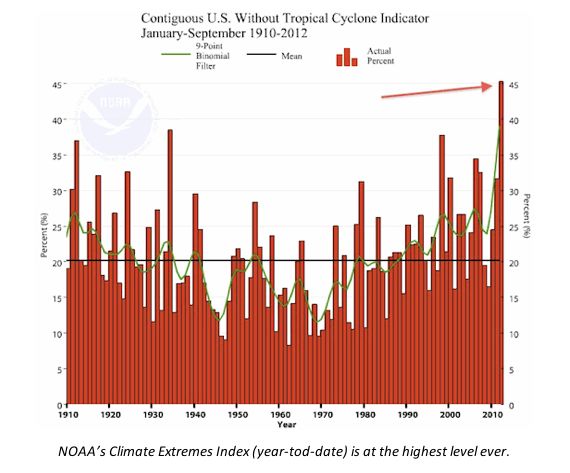Failure to Include Climate Change Makes Mockery of FEMA Policy
Lack or Reliable Flood Maps Suggests Need for Rebuild Moratorium
FEMA just released new flood maps in the wake of Sandy (see the AP story: FEMA – NJ Coastal flood risk worse than thought).
The maps are interactive and you can view them here.
The maps make a mockery of FEMA’s “Climate Change Adaptation Policy Statement” issued on Jan. 23, 2012. That Policy states:
While the scope, severity, and pace of future climate change impacts are difficult to predict, it is clear that potential changes could afffect our Agency’s ability to fulfill its mission. The challenges posed by climate change, such as more intense storms, frequent heavy precipitation, heat waves, drought, extreme flooding, and higer sea levels could significantly alter the types and magnitudes of hazards faced by communities and the emergency management professionals that serve them. […]
The need to address risks associated with future disaster-related events, including those that may be linked to climate change, is inherent to FEMA’s long-term vision of promoting physical and economic loss reduction and life saving measures. Working within existing statutes and authorities, FEMA will strive to be consistent in the Agency’s incorporation of climate change adaptation actions and activities in on-going plans, policies, and procedures.
The FEMA policy statement includes changes to FEMA Policy and Procedure that pledge to incorporate climate change adaptation in, among others, the following critical FEMA programs and functions, including:
- FEMA will continue to study the impacts of climate change on the National Flood Insurance Program (NFIP) and incorporate climate change considerations in the NFIP reform effort
- … FEMA will evaluate the potential impact climate change may have on existing risk data and the corresponding implications for Threat Hazard Identification Risk Assessment
The updated FEMA maps did not comply with this FEMA policy.
[Update – and fail to reflect the most recent NOAA science on extreme weather as well (h/t Bill Neil):
NOAA’s National Climatic Data Center (NCDC) reported Tuesday in its “State of the Climate” for September that the Climate Extremes Index for the period January-through-September was over the highest ever — and over twice the average value — since record-keeping began in 1910.
National Oceanic and Atmospheric Administration (aka NOAA), which put out a news release explaining how global warming drives extreme weather in North America:
“Our research reveals a change in the summer Arctic wind pattern over the past six years. This shift demonstrates a physical connection between reduced Arctic sea ice in the summer, loss of Greenland ice, and potentially, weather in North American and Europe,” said [NOAA’s James] Overland, an oceanographer who leads the laboratory’s Coastal and Arctic Research Division.
The shift provides additional evidence that changes in the Arctic are not only directly because of global warming, as shown by warmer air and sea temperatures, but are also part of an “Arctic amplification” through which multiple Arctic-specific physical processes interact to accelerate temperature change, ice variability, and ecological impacts.
The public should take these new FEMA maps with a major grain of salt, because the maps are fatally flawed and will promote and allow rebuilding in hazardous locations and at elevations that scientists know will be wiped out by future sea level rise and climate change driven storms.
Private insurance companies and financial institutions surely know of these risks, so they may be reluctant to finance dangerous rebuilding, regardless of new FEMA maps.
Just to be clear – as the AP story corrrectly noted, the updated FEMA maps do NOT include sea level rise:
The maps do not incorporate projections that the sea level will rise at an accelerating rate.
That means they they probably also don’t incorporate the more frequent and intense storms that climate change models predict.
[Yikes! The Asbury Park Press reports that in addition to failure to consider sea level rise and climate change, the maps don’t even address Sandy elevations!
The maps, which have been in the planning process for two years, do not include data from Sandy, as they were completed before the storm struck New Jersey on Oct. 29.
These FEMA mapping failures to included “projected conditions” resulting from climate change are no accident.
FEMA regulations actually prohibit consideration of “future condtions“:
§ 65.6 Revision of base flood elevation determinations.
(3) Revisions cannot be made based on the effects of proposed projects or future conditions.
So FEMA knows that their Climate Change Adaptation Policy Statement is a Sham and that if they are serious, that their regulations must change.
FEMA regulations also restrict the ability of academics and public interest groups to petition FEMA for map and base flood elevation changes.
FEMA must get serious and not just issue unenforceable policy statements and incorporate the latest climate change projections in their maps and other programs – if not, they give the public a dangerous false sense of security and invite further future disaster.


Pingback: ray ban sunglasses replica
Pingback: Cheap Beats Headphones
Pingback: Lululemon Outlet Online
Pingback: lululemon outlet online
Pingback: giuseppe zanotti outlet
Pingback: lululemon factory outlet online
Pingback: Replica RayBan Wayfarer
Pingback: Ray Ban Sunglasses online
Pingback: Cheap Ray Ban Sunglasses
Pingback: Cheap Beats solo
Pingback: safest wow gold
Pingback: http://www.whatsupmuskoka.com/sitepages/pollnews.asp
Pingback: cheap ray ban sunglasses
Pingback: wow gold
Pingback: |cheap christian louboutin heels
Pingback: fitflop sko
Pingback: pay4you
Pingback: fitflop soldes
Pingback: roger vivier sale
Pingback: fitflop salg
Pingback: crmkxfksgdafagafhdjkshgeyug
Pingback: nike roshe run women grey
Pingback: nike mercurial vapor superfly iv
Pingback: nike free outlet